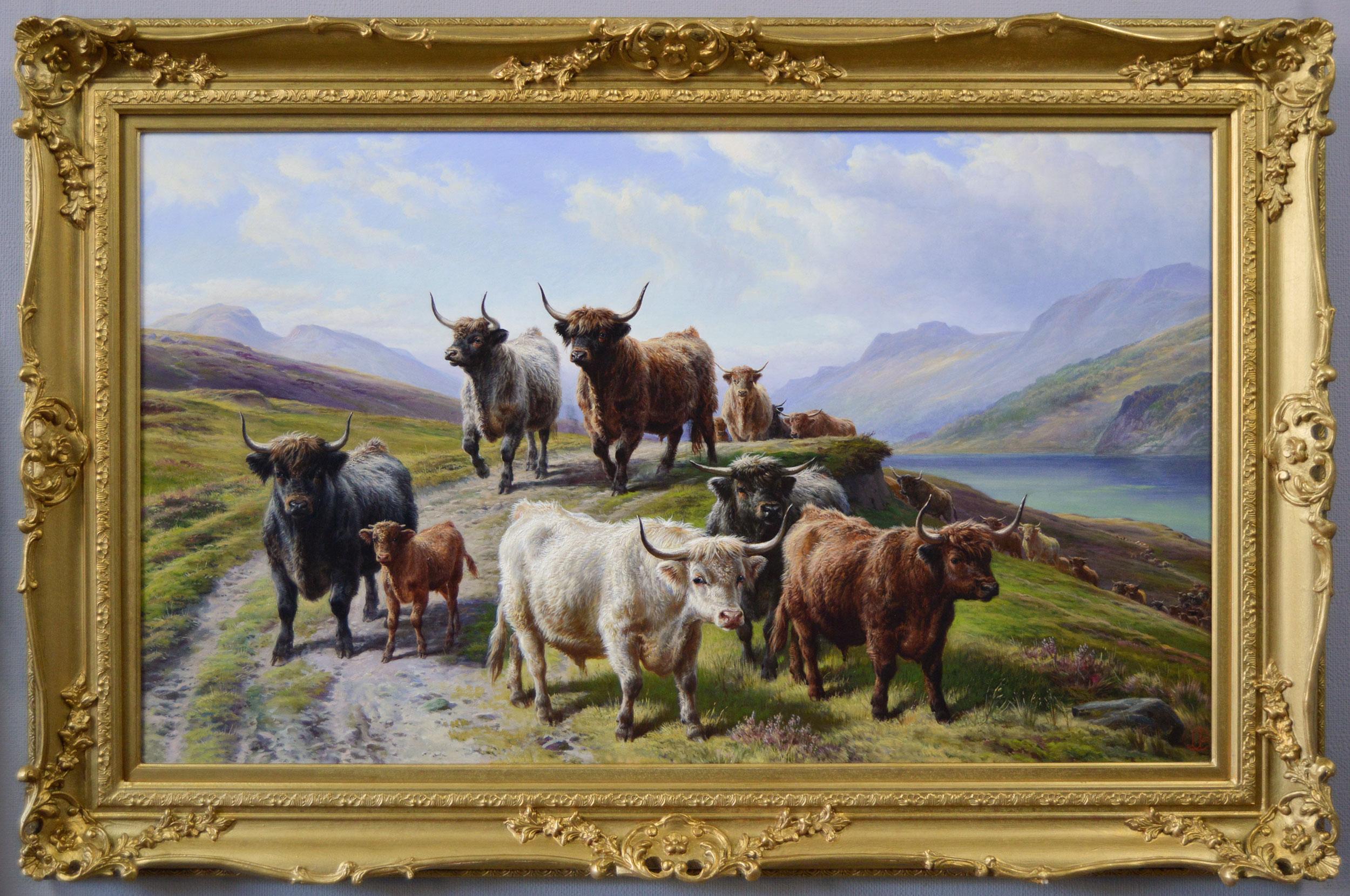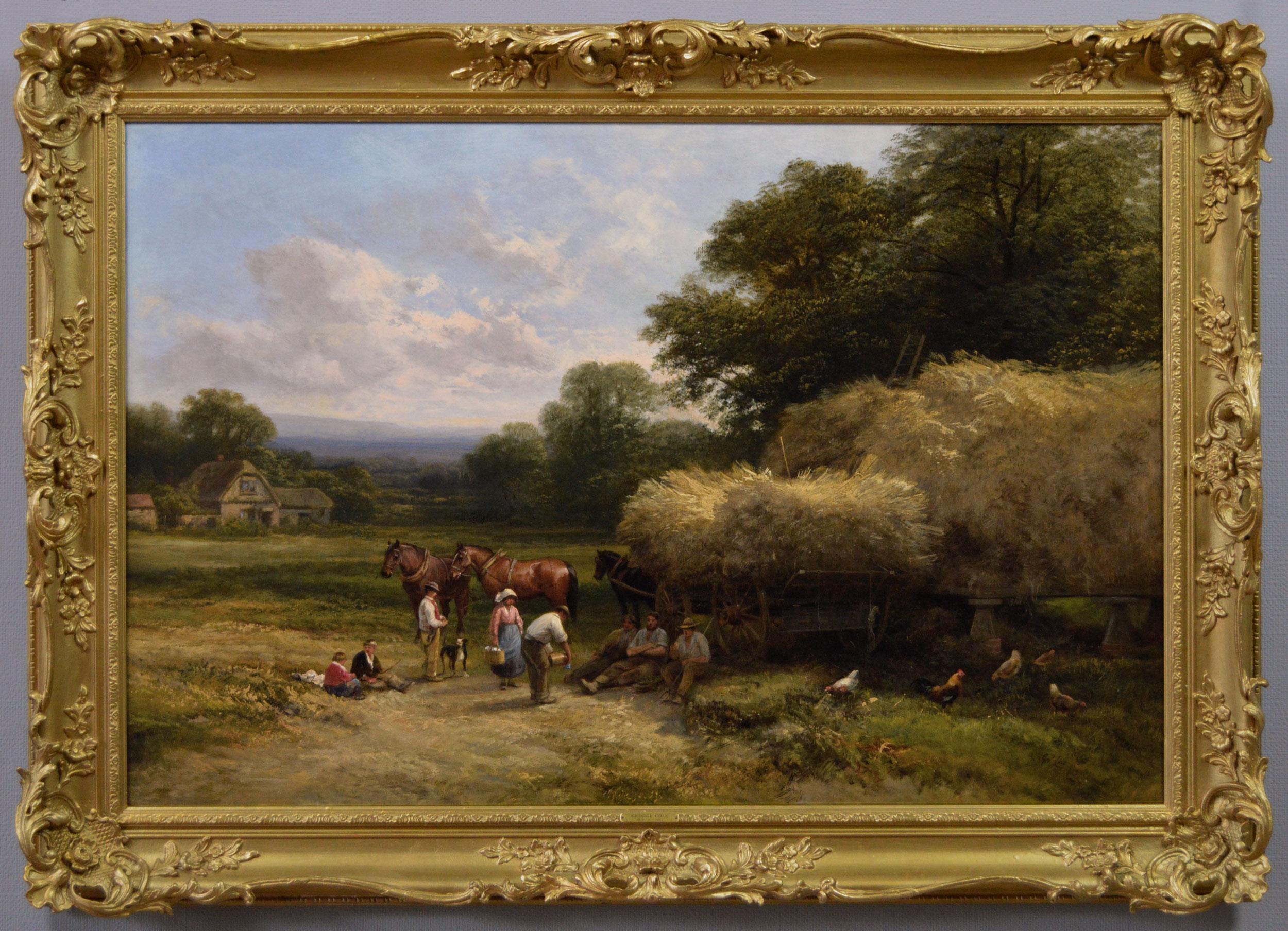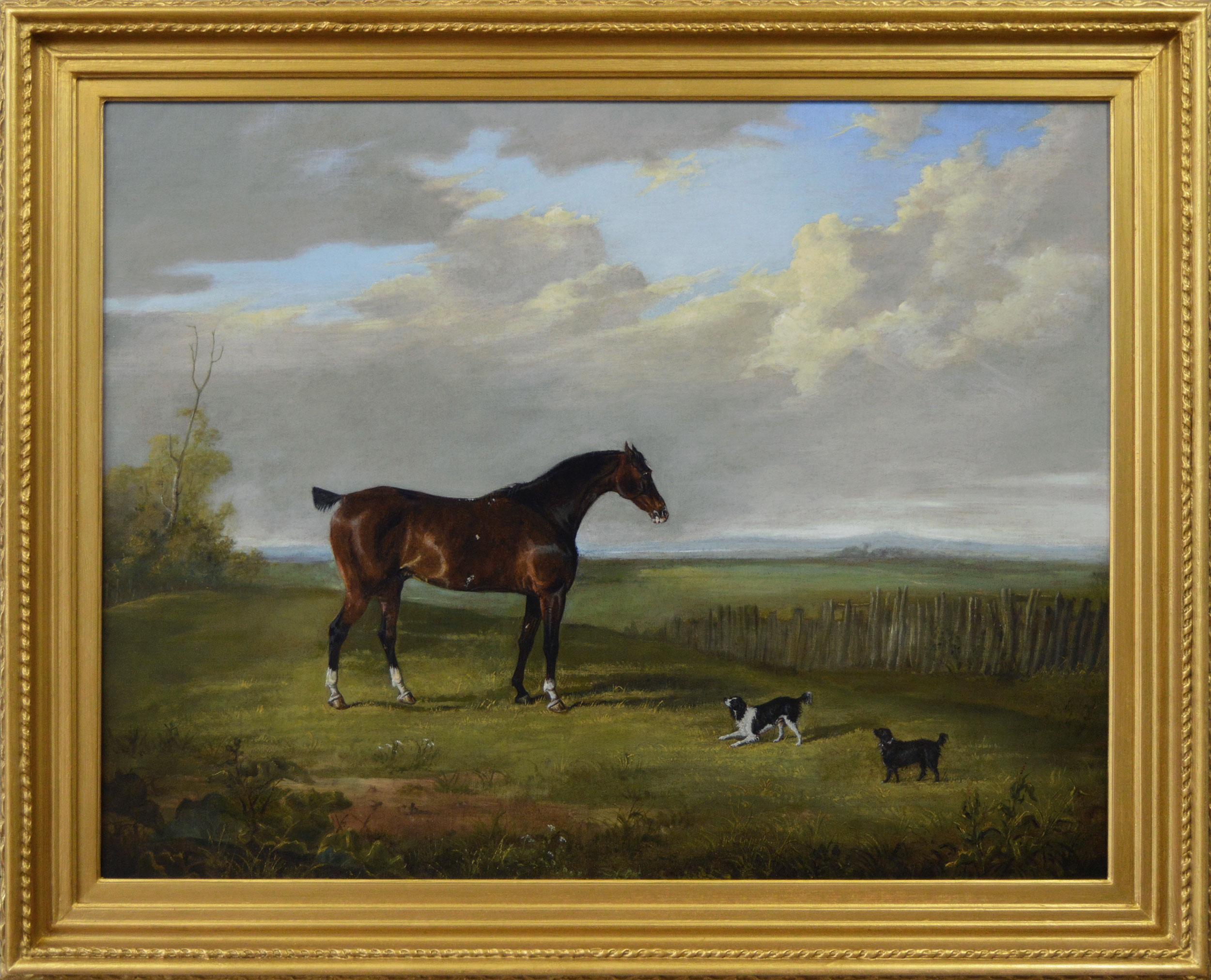Henry H. Parker19th Century pair of river landscape oil paintings with cattle C1900
C1900
About the Item
- Creator:Henry H. Parker (1858 - 1930, British)
- Creation Year:C1900
- Dimensions:Height: 17.5 in (44.45 cm)Width: 23.5 in (59.69 cm)Depth: 2.5 in (6.35 cm)
- Medium:
- Movement & Style:
- Period:
- Condition:
- Gallery Location:Moreton-In-Marsh, GB
- Reference Number:1stDibs: LU156213615072
Henry H. Parker
Born in 1858, Henry H. Parker was a British artist working at the end of the Victorian era. It is believed that he was born and lived in London, where he studied at Saint Martin's School of Art. Parker started his working life as an illustrator for the Illustrated London News, and by the age of 23 had become known as a landscape painter.
Parker's landscapes are lush and tranquil, frequently featuring a lone figure in a boat or walking down a country path. The scenes are often sunny and bright and the waters are calm and soothing.
Parker's style shows a great influence by the Impressionists, through his use of bright colors and quick brush strokes, but a definite understanding of the academic principles is also displayed. This style of painting was very typical for the late Victorian landscape artists who strove to incorporate the new Impressionist techniques in their more traditional paintings. Parker's landscapes and skies were created with a free but controlled application of paint, while the watery areas of his work were handled in the more traditional way — using glazes to create depth and reflections. His paintings are well composed, beautifully balanced and capture the landscape in its most pure and natural state. This colorful and free look was a welcome relief to the traditional Victorian landscapes of the previous decades and this, coupled with Parker's choice of subject matter, brought him great success.
Parker painted mainly in the South East of England, in Surrey, Sussex, and along the Thames where he frequently stayed at Goring and Streatley. He also painted in the Worcestershire area and in Wales. He would often sign and title his works, with their exact location, on the reverse.
Throughout his life, Parker enjoyed widespread popularity as an artist, and this is today witnessed by the number of his works consigned to galleries and museums throughout the world. From 1923 onward, Parker exhibited in the United States, especially in Chicago, where he was unable to meet the demand for his pictures. His paintings were also popular with the Canadians and were hung in all the leading clubs throughout Canada and the States.
Of final note, it is very interesting that Parker was one of only a handful of artists, of his caliber, to never exhibit at the major exhibition halls in England during his lifetime and whose popularity has increased over the years. Parker's works can be found in the following museums and galleries: Birmingham, Liverpool, Eastbourne, Hartlepool, Bradford (England); the Manitoba Club, Winnipeg, St James's, Montreal (Canada); and the Auckland Museum (New Zealand).
Find Henry H. Parker paintings on 1stDibs.
(Biography provided by David Brooker Fine Art)
- ShippingRetrieving quote...Ships From: Moreton-In-Marsh, United Kingdom
- Return PolicyA return for this item may be initiated within 3 days of delivery.
- 19th Century landscape oil painting of sheep grazing on a clifftopBy Charles Jones (b.1836)Located in Moreton-In-Marsh, GloucestershireCharles Jones British, (1836-1892) Sheep Grazing on a Cliff Top Oil on canvas, signed with monogram Image size: 7.5 inches x 11.5 inches Size including frame: 13.5 inches x 17.5 inches Charles Jones was an animal painter who was born in Stepney, London in 1836. He was the son of the artist Samuel John Egbert Jones (1797-1861) and Dinah Jones. He lived with his parents and 9 siblings in Mile End and was a pupil of his father. In September 1859, he married Frances Rosalinda Downe, who was born in America. His son Arthur Bertram Loud (1863-1930) also became an artist. They lived at 12 Hayes Place, Lisson Grove from where he made his debut in London at the Royal Academy in 1861. He also exhibited at the British Institution, Suffolk Street, New Watercolour Society, Royal Institute of Oil Painters and the Royal Institute of Painters in Watercolours. By 1867, he had become a successful artist and had moved to 7 Paragon Place, Brixton Hill. From 1874, he lived at Heathercroft, Balham Hill where he spent the rest of his life. As well as the major London galleries, he also exhibited provincially at various locations including: the Royal Cambrian Academy where he was elected a member in 1886, the Glasgow Institute of Fine Arts, Manchester City Art Gallery, Royal Hibernian Academy, Royal Society of British Artists, Birmingham and the Walker Art Gallery, Liverpool. Some of the smaller more intimate galleries he exhibited at were Arthur Tooth & Sons and Thomas Richardson...Category
19th Century Victorian Animal Paintings
MaterialsCanvas, Oil
- 19th Century landscape oil painting of cattleBy Thomas Baker of LeamingtonLocated in Moreton-In-Marsh, GloucestershireThomas Baker British, (1809-1864) Cows with a Willow Tree Oil on canvas, signed & dated 1860 Image size: 14 inches x 11.75 inches Size including frame: 20.5 inches x 18.25 inches P...Category
19th Century Victorian Landscape Paintings
MaterialsCanvas, Oil
- 19th Century landscape genre oil painting of farmworkers with horses & a dogBy George ColeLocated in Moreton-In-Marsh, GloucestershireGeorge Cole British, (1810-1883) Rick Making, Lunchtime Oil on canvas, signed & dated 1883 Image size: 23.5 inches x 35.5 inches Size including frame: 30.5 inches x 42.5 inches Prove...Category
19th Century Victorian Animal Paintings
MaterialsCanvas, Oil
- 19th Century Scottish Highland landscape oil painting of Loch LubnaigBy Alfred de Breanski Sr.Located in Moreton-In-Marsh, GloucestershireAlfred de Breanski Snr British, (1852-1928) The Head of Loch Lubnaig Oil on canvas, signed & transcribed verso Image size: 23.5 inches x 35.5 inches Size including frame: 32.25 inch...Category
19th Century Victorian Landscape Paintings
MaterialsCanvas, Oil
- 19th Century landscape oil painting of the river Lledr near Bettws-y-coedBy Henry H. ParkerLocated in Moreton-In-Marsh, GloucestershireHenry H Parker British, (1858-1930) The River Lledr, Bettws-y-coed Oil on canvas, signed, further signed & inscribed verso Image size: 19.5 inches x 29.5 inc...Category
19th Century Victorian Landscape Paintings
MaterialsCanvas, Oil
- 19th Century Scottish landscape oil painting of Highland sheep at Glen CoeBy William WatsonLocated in Moreton-In-Marsh, GloucestershireWilliam Watson Jnr British, (1847-1921) Morning, Head of Glen Coe Oil on canvas, signed & dated 1897, further inscribed verso Image size: 12.5 inches x 18.5 inches Size including frame: 19.75 inches x 25.75 inches A superb Scottish landscape painting of Highland Sheep at the head of Glen Coe by William Watson. The sheep and their lambs are depicted grazing in the morning light with the dramatic mountains beyond. Glen Coe is a valley located in the Highlands to the North of the county of Argyll and close to the province of Lochaber. The area, which became infamous for the Massacre of Glencoe is one of Scotland’s most scenic Highland glens. William Watson was born in Islington in 1847, the son of the London miniature painter William John Watson (1810-1871) and his wife Caroline (née Butcher). His brothers Charles Watson (1837-1900) and Robert Watson (1855-1921) were also artists. His father seems to have travelled around and after spending time in Brighton, the family moved to Bransford Road in Worcester during the early part of the 1860’s. As well as being taught by his father, Watson received his early training in the studio of Sir Francis Grant PRA (1803-1878). He later became a pupil of Sir Edwin Henry Landseer RA (1802-1873) and Rosa Bonheur (1822–1899). Both Landseer and Bonheur had a great influence on his work and he began specialising in scenes of cattle and sheep. By 1866 he had become a full time artist and began exhibiting at the Royal Society of British Artists. Perhaps to take advantage of the inspiring scenery, Watson moved to Birkenhead, Cheshire where in 1871 he met and married Eleanor Davies who was from Caernarvonshire. Four of their children Sidney Watson (1881-1931), Caroline Ellen Watson (1871-1947), William Robert Charles Watson (1873-1928) and Walter James Watson...Category
19th Century Victorian Animal Paintings
MaterialsOil, Canvas
- Alfred Walter Williams, Barmouth Sands, North Wales, Oil PaintingLocated in Cheltenham, GBThis late 19th-century oil painting by British artist Alfred Walter Williams (1824-1905) depicts an expansive view across Barmouth Sands in North Wales. The relaxed golden sands str...Category
1880s Victorian Landscape Paintings
MaterialsCanvas, Oil
- Rosa Müller, Moel Siabod From The Llugwy River, Snowdonia, North WalesLocated in Cheltenham, GBThis late 19th-century oil painting by British artist Rosa Müller (1822-1914) depicts the Moel Siabod mountain in Snowdonia, from the winding River Llugwy. Two children play on the r...Category
1870s Victorian Landscape Paintings
MaterialsCanvas, Oil
- Very Large 19th Century Scottish Victorian Oil Cattle Watering Highland LochLocated in Cirencester, GloucestershireArtist/ School: Scottish School, 19th century Title: Scottish Highland Landscape, with cattle watering on the loch Medium: oil on canvas, framed Framed: 39 x 46 inches Painting: 2...Category
19th Century Victorian Landscape Paintings
MaterialsCanvas, Oil
- Pigeons Doves in Ornamental Park Landscape, Early Bird original oil paintingLocated in Cirencester, GloucestershireArtist/ School: English School, early 1900's Title: Doves or Pigeons in an ornamental park landscape setting. Medium: oil on canvas, framed Size : 10.5 x 15 inches Framed: 8 x 12...Category
Early 20th Century Victorian Animal Paintings
MaterialsCanvas, Oil
- Fine 19th Century British Dog Painting Dogs Chasing Rabbit Signed & dated 1896Located in Cirencester, Gloucestershire'Tempt me Not' by Frederick French (British flourished 1883-1916) signed with monogram lower left, signed and dated 1896 to the reverse, titled to frame plaque oil painting on canva...Category
1890s Victorian Animal Paintings
MaterialsCanvas, Oil
- The Fox and Cubs In Woodland Signed British Oil PaintingLocated in Cirencester, GloucestershireAlan King, British Artist (1946- 2003) signed oil on canvas, framed framed: 27 x 37 inches canvas: 20 x 30 inches provenance: UK collection The painting is ...Category
20th Century Victorian Landscape Paintings
MaterialsCanvas, Oil






